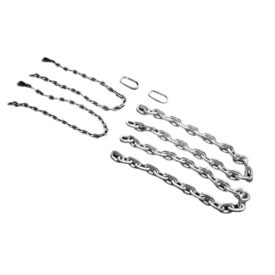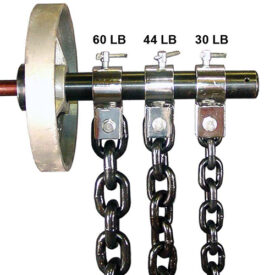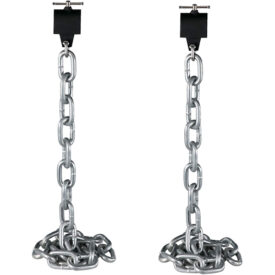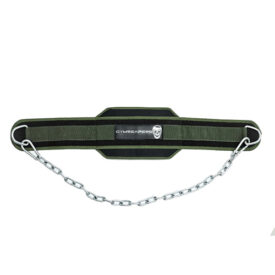Lifting chains are a popular tool for athletes and fitness enthusiasts trying to increase the intensity of their workouts. When chains are used for exercise, they’re referred to as accommodating resistance — a way to make the lift easier or more difficult depending on where you are in your range of motion. If you’re building out your home gym and trying to spice up traditional sets without buying a bunch of extra weight plates, lifting chains may be worth the investment.
To use lifting chains, you can add them to a barbell, or hang them over your shoulders during bodyweight exercises for added resistance. During barbell work, most of the chain rests on the ground at the bottom of the movement (when you are at your weakest) and lifts off the ground at the top of the movement (when you are at your strongest) to add resistance. For bodyweight exercises, the chain rests around your neck to create more resistance during movements that otherwise would not include added weight. In this article, we’ve listed our favorite lifting chains to help you progress your strength training journey.
Best Lifting Chains
- Best Lifting Chains Overall: Rogue Chain Kit
- Most Durable Lifting Chains: Ader Barbell Olympic Weight Lifting Chain Set
- Best Heavy Lifting Chains: Rogue Chain Kit
- Best Lifting Chains for the Money: Happybuy Weight Lifting Chains
- Best Dip Belt With Chain: Gymreapers Dip Belt
Best Lifting Chains Overall
Our top pick comes with both a carabiner and a leader chain to hang your lifting chains from — the full package when it comes to these kits.
Rogue Chain Kit
The Rogue Chain Kit comes in 10-pound lengths with ½-inch chains and 15-pound lengths of ⅝-inch chains options. Both kits come with two 4-foot lengths of ¼-inch leader chains and carabiners, which allow you to hang your weights properly from the highest position, so they rest on the ground in the bottom position. All of the chains are zinc electroplated to prevent rust, which can be especially useful if you like putting the chains around your neck (where things can get extra sweaty) for dips or stair runs.

This full-package, versatile lifting chain kit will boost your strength training routine with ease. Each pair is zinc electroplated to prevent rust, and they're light enough to stack for heavier lifts.
Who Should Buy The Rogue Chain Kit
- Lifters who want the full-package with everything they need to use their chains properly.
- Anyone who does a lot of back squats or bench presses and wants a leader chain to hang their lifting chains on the barbell.
- Athletes who are worried about rust damage from sweat.
Who Shouldn’t Buy The Rogue Chain Kit
- Customers who just want to buy a standalone lifting chain.
This pick is versatile and comes with all the necessary parts to make the most of your lifting chains — you won’t have to worry about purchasing any accessories.
Most Durable Lifting Chains
This pick is made of heavy-duty forged steel, comes with sturdy collars, and can withstand any lifting schedule you throw its way.
Ader Barbell Olympic Weight Lifting Chain Set
The Ader Barbell Olympic Weight Lifting Chain Set comes in 30-pound, 45-pound, and 60-pound sets in either black or zinc. Dipped in oil and a non-toxic oxide finish, these different sized sets are ½-inch, ⅝-inch, and ¾-inch, respectively. They all come with shaft collars to easily secure the heavy-duty forged steel chains to a barbell so that the links are on the ground in the bottom position and off the ground in the top position. However, some have complained about the oily feel of the finish, so if that is something you think may bother you, we would recommend avoiding this pick.

This heavy-duty forged steel lifting chain set will last for years and push your limits. These chains come in 30-pound, 45-pound, and 60-pound sets and have an oil and a non-toxic oxide finish.
Who Should Buy The Ader Barbell Olympic Weight Lifting Chain Set
- Athletes who want lifting chains that come with collars to hold their chains in the correct position.
- Lifters who want long-lasting chains made of heavy-duty forged steel.
- Anyone who wants a variety of weight options to choose from.
Who Shouldn’t Buy The Ader Barbell Olympic Weight Lifting Chain Set
- Anyone looking for an inexpensive set of lifting chains — these chains are pricier than some others on the market.
- Those who don’t like the feeling of an oil finish.
For a lasting set of steel lifting chains, you can’t go wrong with the Ader Barbell Olympic Weight Lifting Chain Set — just be aware of the oil finish if slimy(ish) chains weird you out.
Best Heavy Lifting Chains
If you’re looking for lifting chains you can stack for a heavier lift, this pick comes in 10- and 15-pound lengths so you can layer up.
Rogue Chain Kit
The Rogue Chain Kit comes in sets of two lifting chains that each include a leader chain and a carabiner to allow for proper usage. The lifting chains themselves are either 10 or 15 pounds, so you can buy multiple sets and stack them for heavier sessions. If you’re throwing these sets over your shoulders for dips, rest assured they are zinc electroplated to prevent any rust that may form from contact with sweat. It’s worth noting that if you want to layer these weights for a heavy lift, you’ll need to account for the 5-pound weight of the leader chain and carabiner that will have to be attached to each lifting chain if you are using a barbell.

This full-package, versatile lifting chain kit will boost your strength training routine with ease. Each pair is zinc electroplated to prevent rust, and they're light enough to stack for heavier lifts.
Who Should Buy The Rogue Chain Kit
- Heavy lifters who want to stack their lifting chains to create extra resistance.
- Anyone who wants a leader chain and carabiner to come with their lifting chains for proper positioning on a barbell.
- Athletes who are concerned about rust and want an outer coating that will help prevent it from forming.
Who Shouldn’t Buy The Rogue Chain Kit
- Athletes who just want to buy a single heavy chain for ease of use.
While you will have to buy multiple kits to create a heavy lift, the size of these makes stacking them easy so you can hit those higher numbers even if the individual chains are lighter.
Best Lifting Chains for the Money
These reasonably priced lifting chains come in three sizes and have a zinc coat to help fight off rust a little better than other metals.
Happybuy Weight Lifting Chains
The Happybuy Weight Lifting Chains come in 26-, 35-, and 44-pound pairs, and each chain has a steel black bar collar with an L screw for securing the lock while you use them for deadlifts or bench presses. These pairs come in silver, blue, or black with a zinc coating for protection, and they are all priced lower than most other chains of the same weight and quality. Plus, each chain has one spring snap hook in the middle that detaches it into two chains to add more weight easily. While these chains may not last as long as some more expensive options, they offer great value and quality for the price.

These lifting chains are sturdy and versatile thanks to their spring snap hook. Plus, they come in 26-, 35-, and 44-pound pairs and won't break the bank.
Who Should Buy The Happybuy Weight Lifting Chains
- Customers looking for a cost-effective option that has similar qualities to higher-priced lifting chains.
- Anyone who wants to stack lifting chains for a heavier lift.
- Athletes who want chains that come with a lock to secure their chains to a barbell.
- Lifters who want a colored option for their lifting chains.
Who Shouldn’t Buy The Happybuy Weight Lifting Chains
- Folks who want the highest level of durability and are willing to pay extra for it.
While these lifting chains are sturdy and versatile thanks to their spring snap hook that allows them to split in two, they cost much less than other options you may run across as you’re browsing the web.
Best Dip Belt With Chain
While you can’t use this pick on a barbell, it can help elevate bodyweight exercises like dips, pull-ups, and more in an easy-to-wear fashion.
Gymreapers Dip Belt
Using the Gymreapers Dip Belt’s 30-inch heavy-duty, thick steel chain, you can attach plates of all weights to kick your bodyweight work up a notch. The belt itself is made of a comfortable cotton and neoprene blend that will stay snug and support your lower back even when you’re adding heavy plates. You can’t use this type of chain on a barbell like you can with many other lifting chains, but this belt allows you to target specific bodyweight exercises in a more comfortable way than a hard link chain does.

For back support and a convenient way to incorporate more weight into your bodyweight movements, you can't go wrong with this dip belt. Its 30-inch heavy-duty, thick steel chain will support weight plates of all sizes.
Who Should Buy The Gymreapers Dip Belt
- Athletes who want to increase the resistance for bodyweight exercises.
- Anyone who prefers using plates to add weight over chains.
- Customers looking for a low-cost alternative to traditional lifting chains.
Who Shouldn’t Buy The Gymreapers Dip Belt
- Lifters who want to use their chains with a barbell.
For added back support and a convenient way to incorporate more weight into your pull-ups, dips, chin-ups, and hip belt squats, the Gymreapers Dip Belt offers a great, cost-effective alternative to basic lifting chains.
Before Buying Lifting Chains Consider
As you’re pondering where to begin your lifting chain search, we realize many lifting chains may appear quite similar. You’ll want to consider your training goals, the weight of your lifts, and your budget to gauge the properties of these picks that could help you out the most.
Your Training Routine
Do you do more bodyweight exercises or barbell exercises? Or do you do a mix of both? These questions are things you’ll want to consider before purchasing a lifting chain. While you can do both bodyweight and barbell work with traditional lifting chains, if you only do bodyweight work, a dip belt will be a much more comfortable and supportive choice than traditional lifting chains.
If you’re only doing barbell work, you’ll probably want to go with traditional chains as you can’t use a dip belt with a barbell. And if you do a mix of both, traditional lifting chains can add extra weight for bodyweight exercises as well as barbell exercises — instead of hooking your weight onto a padded belt though, you’ll have to drape it over your neck and shoulders, which can be less comfortable.
Desired Chain Weight
You’ll want to consider how heavy you’re going to be lifting before choosing your set of lifting chains. While it may seem counterintuitive, if you’re going to lift heavier, you’ll want to obtain lighter chains that you can stack and adjust. For example, if you have four 30-pound chains, there isn’t a whole lot of wiggle room there when it comes to adjusting the weight on the barbell. If you have 10- or 15-pound chains, you can stack your chains on each side of the barbell with more variety. While it could still make sense to have a heavier set of two 30-pound chains, it’s not a bad idea to l have lighter ones at the ready if you’re using chains to train for a 1rm.
If you’re not interested in lifting super heavy, you need only consider how much weight you want to lift most regularly. Lifting chains generally range from 10 pounds to upwards of 50 pounds per chain.
Price
Lifting chains can run pretty expensive depending on the quality and weight you choose. If you’re going to buy traditional lifting chains, you should be prepared to spend anywhere up to $500 on a pair or kit. Dip belts are less expensive since they are simply the support for a plate you already own or use at a public gym. But, dip belts are also less versatile. Follow where your budget leads you here — if you can’t afford the most expensive set, steel chains are pretty hard to break, so there will be plenty of quality picks in different price ranges for you to consider.
How We Decide the Best
When sifting through our lifting chain options, we came across many similarities — after all, most chains are made of durable steel and offer similar benefits. However, when pulling together this list, we looked most at durability and versatility to make our picks.
Durability
The main attribute that contributes to a pair of lifting chains’ durability is their material. Pretty much every chain is made out of steel, so the odds of them breaking are slim to none unless a freak accident occurs, so the main points of durability we assess are chipping on the main chains, leader chains, and collars if they have them. Usually, well-made chains will come with an anti-chip coating, so this is never really a huge issue for many, making the primary durability concerns the collars and leader chains.
The leader chains are the small chains that will attach the larger chains to a barbell. These leader chains promote accurate length gauging and allow for an “even” lay on the barbell collars, as larger links can be slightly uneven. If the chain has collars, then it’s best if they’re also made of steel . After all, a chain that lasts with a broken attached collar isn’t particularly beneficial for the avid fitness enthusiast.
Versatility
The main points regarding versatility that really matter are leader chains and variance of weight. Leader chains are great because they allow chains to be adjusted for a variety of heights and can attach to nearly every piece of equipment.
Weight variance is useful for selecting chains based on one’s fitness level. More advanced athletes will be able to use heavier chains — and they’ll want to stack lighter chains as well — so having both options on this list was vital for us.
Final Word
Lifting chains are useful pieces of equipment that can be incorporated into a variety of exercises at the gym. Typically, lifters will reach for chains when they want to break through sticking points and improve their top-end lifting potential. Whether you’re new to lifting or have been lifting for years, the weight range of these picks is sure to satisfy your fitness needs.
Before you buy, make sure you’ve weighed all options — heavy or light, leader chain or collar, traditional chains or dip belt — to find the pick on this list that is going to help you reach new heights in your training journey. Once you’ve made your decision, chain up, and prepare to walk out of the gym just a little more wobbly than you did before.
FAQs
What are chain lifts good for?
Chain lifts add resistance to both barbell work and bodyweight movements. With barbell work, we refer to this resistance as accommodating resistance. This form of resistance allows equal difficulty during all parts of each movement. At the bottom of the rep (when you are at your weakest), the chains rest on the ground, relieving some of the resistance. At the top of the rep (when you are at your strongest), the chains lift off the ground creating more resistance. For bodyweight movements, chain lifts simply provide more resistance throughout the movement than there would be using just bodyweight.
How heavy are lifting chains?
Lifting chains generally range from around 10 to 50 pounds each. If you want to lift heavier, you can use multiple sets to layer up to your desired weight.
Are chains better than plates?
Not necessarily — this is a personal preference. Lifting chains allow for accommodating resistance that regular plates do not allow for, but using regular plates can help build muscle just as well. Lifting chains may target your core more as they can be more difficult to balance during lower-body movements like reverse lunges and back squats. Overall, neither is a replacement for the other — they can be done in congruence for optimal results.